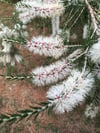Melaleuca lanceolata - Moonah
Melaleuca lanceolata - Moonah
Moonah (Melaleuca lanceolata) is a distinctive native Australian plant well-suited to coastal regions and sandy soils. Its unique appearance and ecological contributions make it a valuable addition to gardens and landscapes.
Habit and Habitat:
Melaleuca lanceolata is a versatile and iconic plant native to Australia. It is commonly found in coastal areas, particularly along sandy shores and dunes. Moonah's adaptability to such environments makes it a vital component of the coastal ecosystem.
Conservation Status:
'Coastal Moonah Woodland' is listed as a threatened plant community under the Flora and Fauna Guarantee Act 1988. Historically, Coastal Moonah Woodland covered extensive areas, but urbanization and clearing have reduced its extent drastically. As land clearing and development persist, this valuable habitat is at risk of extinction.
Ecosystem Distribution:
This plant thrives in coastal habitats and is well-suited for stabilizing sandy shores and dunes. Its deep roots help prevent erosion, making it an important contributor to the health of coastal ecosystems.
Planting Companions:
Moonah (Melaleuca lanceolata) can be paired with other native coastal plants like Banksias and Leucophyta, creating a visually appealing and ecologically sound landscape design.
Human and Wildlife Uses:
Indigenous Australians valued Moonah (Melaleuca lanceolata) for its wood, which they skillfully crafted into tools for various purposes. This historical use showcases the plant's cultural and practical significance. Moonah also provides habitat and shelter for various bird species, contributing to local biodiversity.
Care Instructions:
For optimal growth, plant Moonah (Melaleuca lanceolata) in a location with full sun to partial shade. Ensure well-draining soil to prevent waterlogging. Regular pruning can help maintain its natural shape and encourage healthy growth.
Size, Height, and Width:
Moonah (Melaleuca lanceolata) typically grows to a height of 3 to 6 meters, with a similar spread. Its moderate size makes it suitable for a variety of garden spaces. This plant produces clusters of cream or pinkish flowers during spring to late summer, adding vibrant colors to the landscape. Its lance-shaped leaves are evergreen, contributing to its visual appeal year-round.
Latin Etymology:
The botanical name Melaleuca lanceolata is derived from Greek words. "Melaleuca" combines "melas" (black) and "leukos" (white), describing the contrasting colors often seen on the plant. "Lanceolata" refers to its long, lance-shaped leaves.
Planting in a Home Garden:
To introduce Moonah to your garden, select a well-draining area with good sun exposure. Its salt tolerance makes it an ideal choice for coastal gardens. Regular watering during establishment is crucial, and mulching can help retain soil moisture.

